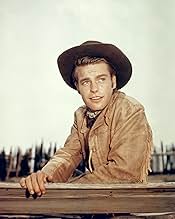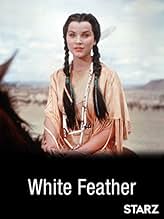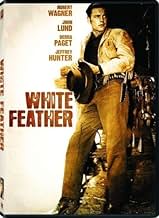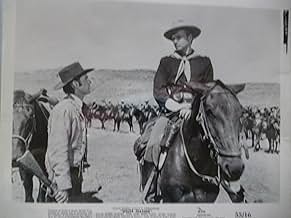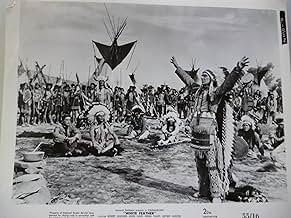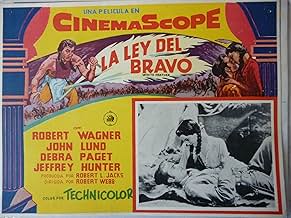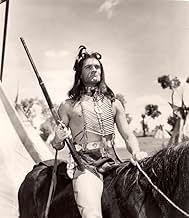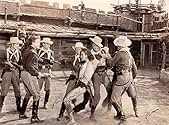IMDb रेटिंग
6.4/10
1.3 हज़ार
आपकी रेटिंग
अपनी भाषा में प्लॉट जोड़ेंIn 1877 Wyoming, during the peace negotiations between the Cheyenne and the USA, an Indian girl falls in love with a land surveyor, causing the ire of her Cheyenne fiance.In 1877 Wyoming, during the peace negotiations between the Cheyenne and the USA, an Indian girl falls in love with a land surveyor, causing the ire of her Cheyenne fiance.In 1877 Wyoming, during the peace negotiations between the Cheyenne and the USA, an Indian girl falls in love with a land surveyor, causing the ire of her Cheyenne fiance.
- निर्देशक
- लेखक
- स्टार
Noah Beery Jr.
- Lt. Ferguson
- (as Noah Beery)
Iron Eyes Cody
- Indian Chief
- (बिना क्रेडिट के)
फ़ीचर्ड समीक्षाएं
White Feather is out of Panoramic Productions, it's directed by Robert D. Webb and stars Robert Wagner, Debra Paget, John Lund, Eduard Franz & Jeffrey Hunter. It's adapted from a John Prebble story by Delmer Daves & Leo Townsend. It was filmed in Durango, Mexico, with Lucien Ballard on cinematography duties (CinemaScope/Technicolor) and Hugo Friedhofer provides the score. Plot centres around the peace mission from the US cavalry to the Cheyenne Indians in Wyoming during the 1870s, but problems arose because a few of the Cheyenne refused to leave their hunting grounds.
One of the few 1950s Westerns to show sympathy towards the Indian plight, White Feather is a well intentioned and well executed movie. It suffers a little from familiarity with Broken Arrow (1950), where Delmer Daves had directed James Stewart and Debra Paget thru a similar script to the one that's now in front of Wagner and Paget; and lets face it-Wagner is no Jimmy Stewart- and Robert Webb is no Delmer Daves-but there's more than enough good here to lift it above many other liberal Westerns.
Away from the endearing and emotive story (and it is as the Cheyenne are forced out of Wyoming by the Federals), the film also boasts high points for the Western fan to gorge upon. It's gorgeously shot in CinemaScope by Ballard, a first class lens-man in the genre, and Friedhofer's score is pulsating, evocative and in tune with the tone of the tale. Also of note is that these Native Americans aren't caricatures or pantomime Indians. They may be being played by white actors (Hunter & Franz do especially good work), but they feel real and come out as the human beings they were. In fact the whole movie looks convincing.
There's some missteps along the way; such as Wagner over acting and having a voice that's sounds out of place in the Wild West, while the romantic angle (Paget is so beautiful here who could not fall in love with her?) does at times threaten to clog up the narrative. But these things don't hurt the film. On the flip side there's the smooth pacing of the piece, it's only when the tense and exciting climax has arrived that you realise how well the slow burn first half was handled. And Webb may well be a second unit director in all but name here, but his construction of the scenes with hundreds of extras is top notch work.
A fine and under seen Western that is based on actual events and doesn't over egg its pudding. 7/10
One of the few 1950s Westerns to show sympathy towards the Indian plight, White Feather is a well intentioned and well executed movie. It suffers a little from familiarity with Broken Arrow (1950), where Delmer Daves had directed James Stewart and Debra Paget thru a similar script to the one that's now in front of Wagner and Paget; and lets face it-Wagner is no Jimmy Stewart- and Robert Webb is no Delmer Daves-but there's more than enough good here to lift it above many other liberal Westerns.
Away from the endearing and emotive story (and it is as the Cheyenne are forced out of Wyoming by the Federals), the film also boasts high points for the Western fan to gorge upon. It's gorgeously shot in CinemaScope by Ballard, a first class lens-man in the genre, and Friedhofer's score is pulsating, evocative and in tune with the tone of the tale. Also of note is that these Native Americans aren't caricatures or pantomime Indians. They may be being played by white actors (Hunter & Franz do especially good work), but they feel real and come out as the human beings they were. In fact the whole movie looks convincing.
There's some missteps along the way; such as Wagner over acting and having a voice that's sounds out of place in the Wild West, while the romantic angle (Paget is so beautiful here who could not fall in love with her?) does at times threaten to clog up the narrative. But these things don't hurt the film. On the flip side there's the smooth pacing of the piece, it's only when the tense and exciting climax has arrived that you realise how well the slow burn first half was handled. And Webb may well be a second unit director in all but name here, but his construction of the scenes with hundreds of extras is top notch work.
A fine and under seen Western that is based on actual events and doesn't over egg its pudding. 7/10
As a "Western movie" buff, I am surprised that this film is not more familiar to aficionados of the genre. It is a near epic, classical film.
Of course, it suffers from the usual defect common to Westerns made in this era: The Native American leads are played by white actors and there isn't adequate time to fully develop all of the characters.
Still, it is a magnificent film. It has elements of Shane, which was made several years before, and of The Searchers, which was made a year after.
The sweep and the grandeur are very reminiscent of John Ford films. No expense was spared in cinematography, locations, and the number of extras that were employed. Hundreds of Native Americans were employed, including women and children of all ages. The number of mounted cavalry approximate the size of a cavalry regiment. There weren't that many mounted soldiers in John Ford's cavalry trilogy. And, it was all achieved without the aid of computer graphics.
The dialog is realistic and the story, itself, is based on a true incident. A young Robert Wagner is very believable and likable in his solid, understated role.
This film is enormously enjoyable. I remember seeing it in the 1950s at a drive-in theater, and if only I could do so again!
Of course, it suffers from the usual defect common to Westerns made in this era: The Native American leads are played by white actors and there isn't adequate time to fully develop all of the characters.
Still, it is a magnificent film. It has elements of Shane, which was made several years before, and of The Searchers, which was made a year after.
The sweep and the grandeur are very reminiscent of John Ford films. No expense was spared in cinematography, locations, and the number of extras that were employed. Hundreds of Native Americans were employed, including women and children of all ages. The number of mounted cavalry approximate the size of a cavalry regiment. There weren't that many mounted soldiers in John Ford's cavalry trilogy. And, it was all achieved without the aid of computer graphics.
The dialog is realistic and the story, itself, is based on a true incident. A young Robert Wagner is very believable and likable in his solid, understated role.
This film is enormously enjoyable. I remember seeing it in the 1950s at a drive-in theater, and if only I could do so again!
The film is a respectful telling of the 1877 campaign in Wyoming to contain the Indians by persuading them to leave the plains, sign the treaty of peace, and move to a new land in the south
Wagner who affirms to colonel John Lund in charge of Fort Laramie that he has no feeling about Indians, makes Indians friends, particularly with two young warriors Little Dog and American Horse...
Complications arise when Chief Broken Hand's daughter Appearing Day (Debra Paget) engaged to American Horse falls in love with Tanner (Wagner) and he with her Tanner's friendship with Little Dog grows slowly but surely It is one of the most enduring traits of the film, having just the right amount of momentum, frustration and humor...
Jeffrey Hunter steals the show with a great performance of the proud warrior Little Dog whose pen does not fit Cheyenne warriors' hand as well as the arrow Little Dog's blood ran hot at the council, gets angry and chooseswith his pal American Horse to meet the troops in battle
Eduard Franz is superb as the venerable Indian chief, Broken Hand, who called the council to tell them that on this day, they have agreed to take the offer of the white man and leave this country Hugh O'Brian is well chosen as Hunter's best friend, American Horse Noah Beery does one of his better work as the obedient cavalry lieutenant
Debra Paget reprises her role as the radiant Indian girl Appearing Day who would be happy in a white man's world We all remember her role as the delicate Indian healer girl Sonseeahray in Delmer Daves' memorable Western "Broken Arrow."
Robert D. Webb captures splendid panoramic shots that site expansive stretches of green fields and blue skies Webb does provide a handful of transcendent moments, the most spellbinding of which is Tanner's participation in honoring his brave friend
Wagner who affirms to colonel John Lund in charge of Fort Laramie that he has no feeling about Indians, makes Indians friends, particularly with two young warriors Little Dog and American Horse...
Complications arise when Chief Broken Hand's daughter Appearing Day (Debra Paget) engaged to American Horse falls in love with Tanner (Wagner) and he with her Tanner's friendship with Little Dog grows slowly but surely It is one of the most enduring traits of the film, having just the right amount of momentum, frustration and humor...
Jeffrey Hunter steals the show with a great performance of the proud warrior Little Dog whose pen does not fit Cheyenne warriors' hand as well as the arrow Little Dog's blood ran hot at the council, gets angry and chooseswith his pal American Horse to meet the troops in battle
Eduard Franz is superb as the venerable Indian chief, Broken Hand, who called the council to tell them that on this day, they have agreed to take the offer of the white man and leave this country Hugh O'Brian is well chosen as Hunter's best friend, American Horse Noah Beery does one of his better work as the obedient cavalry lieutenant
Debra Paget reprises her role as the radiant Indian girl Appearing Day who would be happy in a white man's world We all remember her role as the delicate Indian healer girl Sonseeahray in Delmer Daves' memorable Western "Broken Arrow."
Robert D. Webb captures splendid panoramic shots that site expansive stretches of green fields and blue skies Webb does provide a handful of transcendent moments, the most spellbinding of which is Tanner's participation in honoring his brave friend
Looked at this on TV as just another western but found myself admiring the camera-work, scenery and performances. Though the direction was at times unexciting, the story was well told and dignified by a good performance by Wagner, so very handsome that it is no wonder the young squaw wants her first kiss with him. Jeffery Hunter, so overlooked but always worth watching, looking incredibly fit (sad to think he died just 4 years later) gave a very strong performance as the head-strong son of the chief, (reminds me of Sal Mineo in Cheyenne Autumn (same story?)) who rides around with Hugh O Brian (Wyatt Earp as an native American!). at the end the scenes between Wagner and Hunter are poignant and stay with you. The sad face of the chief says it all. The film was just a bit overlong and drags in parts which meant I missed bits that I should not have done, but there are some magnificent scenery and cavalry and Indian charges.
This is one of a number of 1950s Westerns which attempted to redress the balance by painting a fairly sympathetic view of the American Indian; even so, to spice up proceedings, we get a couple of rebels (second lead Jeffrey Hunter among them) opposing the impending peace treaty offered by the white man. Incidentally, though inspired by a factual incident, the film's plot line basically mingles elements from two contemporary examples of the genre BROKEN ARROW (1950; whose director, Delmer Daves, contributed to the script of this one) and ARROWHEAD (1953). With this in mind, the film doesn't really bring anything new to the table but, made with consummate Hollywood professionalism, the result is undeniably entertaining nonetheless.
Casting is adequate, too: apart from the afore-mentioned Hunter (though not exactly convincing as a redskin), we get Robert Wagner as an all-too-young Government agent hero who mediates between the two parties, Debra Paget (in a virtual reprise of her BROKEN ARROW role and who eventually defies her people by eloping with Wagner), John Lund as the experienced Cavalry officer in charge, Eduard Franz as Hunter's dignified chieftain father, Hugh O'Brian (as with Peter Graves in the same director's BENEATH THE 12-MILE REEF [1953], a viewing of which preceded this one, he's the heroine's brash but unloved intended), Virginia Leith as a more mature secondary love interest for Wagner, and Emile Meyer as her racist storekeeper father. By the way, I've just taped the first cinematic adaptation of Ira Levin's thrller A KISS BEFORE DYING (1956) off Cable TV which I noticed shares a remarkable number of cast and crew members with the title under review (not least its hunky stars)!
Being a largely outdoor film and in order to supply the appropriate grandeur, Lucien Ballard's widescreen photography is rather frustratingly limited to long or medium shots which, when screened on a normal-sized TV set, unfortunately leads to a certain detachment on the viewer's part; by the way, in the accompanying poster gallery on the DVD, the fact that patrons would be watching a "Cinemascope" production was deemed a bigger draw than even the stars involved! The film culminates with an unusual sort of showdown as Hunter and O'Brian face an entire cavalry unit (apparently an Indian battle custom which explains the film's title) however, the duo's come-uppance sees the personal intervention of Franz, who's not pleased with their 'brave' gesture; this is then followed by a lengthy (and, I'd even say, unwarranted) scene in which Wagner meticulously prepares Hunter for burial.
The Fox DVD includes quite a nice assortment of extras: these include a reproduction of the original pressbook (filled with amusingly irrelevant ballyhoo), a reasonably comprehensive photo gallery, and a number of trailers for the studio's other catalog entries in the genre (among them the desirable Victor Mature vehicle FURY AT FURNACE CREEK [1948] surprisingly narrated and carrying the personal endorsement of none other than Gregory Peck! and latterday black-and-white potboiler CONVICT STAGE [1965], which I'd never heard of myself and can't fathom why it was even deemed worthy of a DVD release).
Casting is adequate, too: apart from the afore-mentioned Hunter (though not exactly convincing as a redskin), we get Robert Wagner as an all-too-young Government agent hero who mediates between the two parties, Debra Paget (in a virtual reprise of her BROKEN ARROW role and who eventually defies her people by eloping with Wagner), John Lund as the experienced Cavalry officer in charge, Eduard Franz as Hunter's dignified chieftain father, Hugh O'Brian (as with Peter Graves in the same director's BENEATH THE 12-MILE REEF [1953], a viewing of which preceded this one, he's the heroine's brash but unloved intended), Virginia Leith as a more mature secondary love interest for Wagner, and Emile Meyer as her racist storekeeper father. By the way, I've just taped the first cinematic adaptation of Ira Levin's thrller A KISS BEFORE DYING (1956) off Cable TV which I noticed shares a remarkable number of cast and crew members with the title under review (not least its hunky stars)!
Being a largely outdoor film and in order to supply the appropriate grandeur, Lucien Ballard's widescreen photography is rather frustratingly limited to long or medium shots which, when screened on a normal-sized TV set, unfortunately leads to a certain detachment on the viewer's part; by the way, in the accompanying poster gallery on the DVD, the fact that patrons would be watching a "Cinemascope" production was deemed a bigger draw than even the stars involved! The film culminates with an unusual sort of showdown as Hunter and O'Brian face an entire cavalry unit (apparently an Indian battle custom which explains the film's title) however, the duo's come-uppance sees the personal intervention of Franz, who's not pleased with their 'brave' gesture; this is then followed by a lengthy (and, I'd even say, unwarranted) scene in which Wagner meticulously prepares Hunter for burial.
The Fox DVD includes quite a nice assortment of extras: these include a reproduction of the original pressbook (filled with amusingly irrelevant ballyhoo), a reasonably comprehensive photo gallery, and a number of trailers for the studio's other catalog entries in the genre (among them the desirable Victor Mature vehicle FURY AT FURNACE CREEK [1948] surprisingly narrated and carrying the personal endorsement of none other than Gregory Peck! and latterday black-and-white potboiler CONVICT STAGE [1965], which I'd never heard of myself and can't fathom why it was even deemed worthy of a DVD release).
क्या आपको पता है
- ट्रिवियाFirst American movie filmed (in 1954) in Durango, Mexico, because art director Jack Martin Smith liked the soundstages in the city and found the surrounding landscapes to be just what he was looking for.
- गूफ़The Army, at no time during the Indian Wars, used Winchester repeating lever action rifles, as shown.
- भाव
Josh Tanner: Eveything you will see in this movie actually happened, with the exception being the Indians' language. For the purposes of this story, they will speak English so that you can understand them.
टॉप पसंद
रेटिंग देने के लिए साइन-इन करें और वैयक्तिकृत सुझावों के लिए वॉचलिस्ट करें
- How long is White Feather?Alexa द्वारा संचालित
विवरण
- रिलीज़ की तारीख़
- कंट्री ऑफ़ ओरिजिन
- भाषा
- इस रूप में भी जाना जाता है
- The Challenge
- फ़िल्माने की जगहें
- Fort Laramie National Historic Site - 965 Gray Rocks Road, Fort Laramie, Wyoming, संयुक्त राज्य अमेरिका(actual Fort at center of events and activities portrayed)
- उत्पादन कंपनी
- IMDbPro पर और कंपनी क्रेडिट देखें
बॉक्स ऑफ़िस
- बजट
- $11,25,000(अनुमानित)
- चलने की अवधि
- 1 घं 42 मि(102 min)
- पक्ष अनुपात
- 2.55 : 1
इस पेज में योगदान दें
किसी बदलाव का सुझाव दें या अनुपलब्ध कॉन्टेंट जोड़ें

